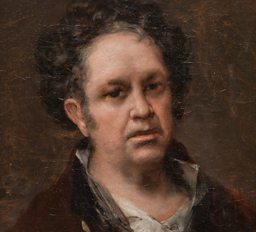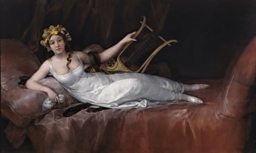Goya's portraits: Seeing through the eyes of a master
7 October 2015
A brilliant new exhibition of portraits by the Spaniard Francisco de Goya at the National Gallery seems to reveal as much about the painter as the sitter. WILLIAM COOK explores the work of an artist whose sudden deafness served only to intensify his vision.

Francisco de Goya y Lucientes was an extraordinary portrait painter. He could see beyond the appearance of his subjects, and convey the deepest aspects of their personalities, the inner workings of their minds.
However there’s never been an exhibition devoted to his portraiture – until now. More than ten years in the making, Goya – The Portraits gathers together 70 of his finest portraits, from Spain to South America, in a display which sheds new light on this perceptive and complex painter. It’s an exhibition that doubles as a biography, of the artist and the man.
‘Imagine sitting for a man like this!’ exclaims the show’s curator, Dr Xavier Bray. ‘He can see right through you!’
Considering what a great portraitist he became, Goya was a late starter. Born in 1746, his early paintings were pedestrian. He didn’t paint his first portrait until 1783.
The Count of Floridablanca, which opens this show, is a stiff and stilted painting. What’s far most interesting is the figure in the corner of the frame. Goya has painted himself, presenting a picture to the Count for his approval. It’s this self-portrait which indicates what incredible portraits were to come.
His big break was painting the family of the Infante Don Luis de Bourbon, the wayward younger brother of Charles III, King of Spain. Other aristocrats saw these paintings, and admired them. He painted a succession of noblemen and noblewomen - his future as a society painter seemed assured.
However in 1792 he was struck down by a mysterious illness, which left him completely deaf. Far from stunting his creativity, deafness liberated him. He became his own man, rather than an aristocratic lackey.
He painted the leading figures of the Spanish Enlightenment, instead of reactionary toffs. His intuitive powers were well suited to these intellectual subjects. "Imagine sitting for a man like this!" exclaims the show’s curator, Dr Xavier Bray. "He can see right through you!"



Related Links
In 1799, King Charles IV appointed Goya his court painter. He’d become a bastion of the establishment, despite his liberal views. His style was informal, but the royal family liked his paintings. Their French cousins had been killed by revolutionaries. They were keen to be portrayed as down-to-earth.
When Wellington liberated Spain, Goya painted his portrait, with the strain of warfare in his eyes.
Goya’s career turned upside down in 1808, when Napoleon conquered Spain. This put him in a tricky position. He was a Spanish patriot, but his ideology was more in tune with the French invaders.
Fortunately, he proved adept at pleasing both sides. When Wellington liberated Spain, Goya painted his portrait, with the strain of warfare in his eyes.
Even this politically expedient picture wasn’t just shallow propaganda – that would have been beyond his powers.
In 1814 the political landscape changed again when Ferdinand VII was reinstalled as King of Spain. Goya retained his position as court painter, but King Ferdinand was suspicious of him, and rightly so.
An arch reactionary, Ferdinand abolished the constitution and brought back the Inquisition, an institution Goya hated. Goya had to stand trial to prove his loyalty. He was cleared of any wrongdoing, but some of his works were denounced as obscene.
His portrait of Ferdinand is one of the most fascinating pictures in this exhibition. There’s nothing disrespectful about it – nothing you can put your finger on – but it’s clearly a picture of a cruel tyrant.
He obeys all the proper protocols, yet, as in all his portraits, the subject’s true character shines through (ironically, Ferdinand also founded the Prado, which now holds the world’s greatest collection of Goya’s work, and has lent ten pictures to this splendid show).

Goya knew his days as a royal painter were numbered. He retreated from public life, painting pictures of his friends for pleasure.
Seeing this show is like stepping out of a time machine and meeting a bunch of people from 200 years ago.
These are some of the finest paintings in this display. "I love the way they look at you, the intensity of the stare," says Bray. Free to paint how he wanted, Goya really let himself go.
"Goya was an extremely sociable person," explains Bray. "He was constantly in touch with what was going on." He was extremely well informed, and highly intelligent. "These portraits keep him sane – they’re like milestones for his life."
In 1824, with the political climate now worse than ever, Goya crossed the border to Bordeaux, to join his friends who’d fled to France to escape the persecution of Ferdinand’s absolutist reign.
Here, in his late seventies and early eighties, he did some of his best work – looser, more impressionistic, and way ahead of its time. "He’s so immediate, so modern," says Bray. He is quite right. Goya broke the rules, and that’s why his art still feels so fresh and vital.
The final painting in this exhibition is a tender portrait of Goya’s grandson. It was the last picture he ever painted. He died in 1828, aged 82. Even in old age, his talent showed no sign of abating.
Seeing this show is like stepping out of a time machine and meeting a bunch of people from 200 years ago. "They’re not people of the past," says Bray. "They’re portraits that can still talk to us today."
Goya – The Portraits is at the National Gallery, London, until 10 January 2016.

Art and Artists: Highlights
-
![]()
Ai Weiwei at the RA
The refugee artist with worldwide status comes to London's Royal Academy
-
![]()
BBC Four Goes Pop!
A week-long celebration of Pop Art across BBC Four, radio and online
-
![]()
Bernat Klein and Kwang Young Chun
Edinburgh’s Dovecot Gallery is hosting two major exhibitions as part of the 2015 Edinburgh Art Festival
-
![]()
Shooting stars: Lost photographs of Audrey Hepburn
An astounding photographic collection by 'Speedy George' Douglas
-
![]()
Meccano for grown-ups: Anthony Caro in Yorkshire
A sculptural mystery tour which takes in several of Britain’s finest galleries
-
![]()
The mysterious world of MC Escher
Just who was the man behind some of the most memorable artworks of the last century?
-
![]()
Crisis, conflict... and coffee
The extraordinary work of award-winning American photojournalist Steve McCurry
-
![]()
Barbara Hepworth: A landscape of her own
A major Tate retrospective of the British sculptor, and the dedicated museums in Yorkshire and Cornwall
More from BBC Arts
-
![]()
Picasso’s ex-factor
Who are the six women who shaped his life and work?
-
![]()
Quiz: Picasso or pixel?
Can you separate the AI fakes from genuine paintings by Pablo Picasso?
-
![]()
Frida: Fiery, fierce and passionate
The extraordinary life of Mexican artist Frida Kahlo, in her own words
-
![]()
Proms 2023: The best bits
From Yuja Wang to Northern Soul, handpicked stand-out moments from this year's Proms












